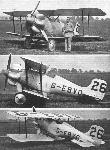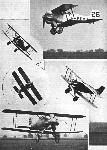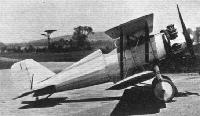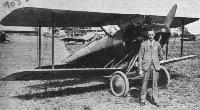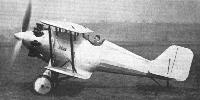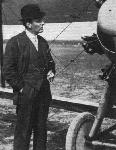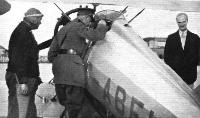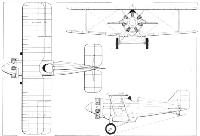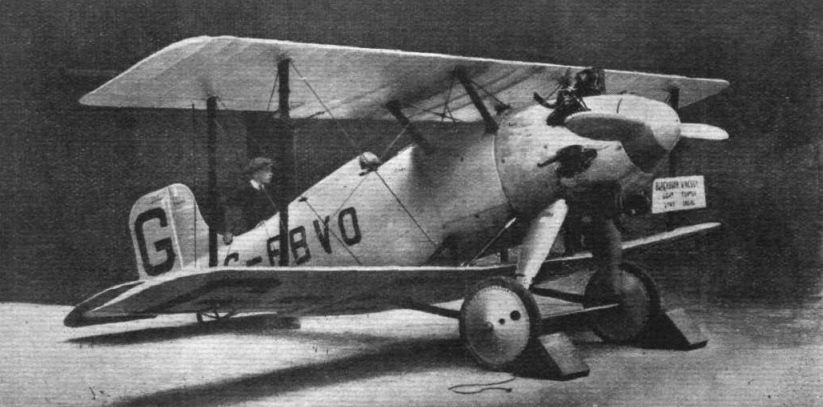
Blackburn F.2 Lincock
В 1928 году в инициативном порядке компания "Blackburn" построила свой второй одноместный истребитель - Blackburn F.2. Самолет представлял собой легкий биплан деревянной конструкции, оснащенный мотором воздушного охлаждения Armstrong Siddeley Lynx IVC мощностью 240л.с.(179 кВт). Фюзеляж схемы полумонокок был обшит фанерой, все остальные поверхности - полотном. Самолет был впервые публично представлен в мае 1928 года под обозначением F.2 Lincock I. В последующий год Lincock неоднократно принимал участие в различных показах, получал хорошие отзывы, но заказов на серийное производство так и не последовало.
Машиной заинтересовалось правительство Канады, но ему требовался самолет металлической конструкции. Специально под этот запрос был построен F.2A Lincock II, оснащенный двигателем Lynx IV мощностью 255 л. с. (190 кВт) с редуктором. Этот самолет проходил испытания в Канаде, но затем был возвращен фирме.
Было построено пять истребителей F.2D Lincock III: по два для Японии и Китая и один остался в собственности "Blackburn". Lincock III был вооружен парой пулеметов, стрелявших через плоскость, ометаемую винтом. В результате интереса, проявленного правительством Италии, фирма "Piaggio" приобрела лицензию на постройку двухместного пилотажного варианта Lincock. Был построен лишь один самолет этого типа, получивший обозначение Piaggio P.11.
ТАКТИКО-ТЕХНИЧЕСКИЕ ХАРАКТЕРИСТИКИ
Blackburn F.2D Lincock III
Тип: одноместный легкий истребитель
Силовая установка: один двигатель воздушного охлаждения Armstrong Siddeley Lynx Major мощностью 270 л. с. (201 кВт)
Летные характеристики: максимальная скорость 264 км/ч у земли; крейсерская скорость 227 км/ч на оптимальной высоте; скороподъемность у земли 506 м/мин; потолок 7010 м; дальность полета 612 км
Масса: пустого 601 кг; максимальная взлетная 944 кг
Размеры: размах крыла 6,86 м; длина 5,94 м; высота 2,24 м; площадь крыльев 15,79 м2
Вооружение: два неподвижных 7,7-мм пулемета Vickers в носовой части фюзеляжа
Описание:
- Blackburn F.2 Lincock
- Flight, October 1928
British Exhibits At The Berlin Aero Show 1928 - Flight, June 1929
BRITISH AIRCRAFT AT OLYMPIA - Flight, November 1929
THE NEW ALL-METAL "LINCOCK”
Фотографии
-
Flight 1928-05 / Flight
Регистрационный номер: G-EBVO [12] INTRODUCING A NEW CLASS IN FIGHTERS: The Blackburn "Lincock" with Armstrong-Siddeley "Lynx" engine is of a type known as a "light fighter." It was demonstrated during the visit to Brough by Squadron-Leader Jack Noakes, who did some amazing "crazy-flying" on it.
-
Flight 1929-07 / Flight
Регистрационный номер: G-EBVO [12] AIRCRAFT IN THE KING'S CUP: Blackburn "Lincock" (180-h.p. Siddeley "Lynx").
-
Aeroplane Monthly 1982-11 / P.Capon - Capon's Corner
Регистрационный номер: G-EBVO [12] Also competing in the 1928 King's Cup race, and seen here at Hamble, was the racy Blackburn Lincock I G-EBVO. This single-seat fighter was powered by one 240 h.p. Armstrong Siddeley Lynx IV and was built at Brough in 1928.
-
Flight 1928-08 / Flight
Регистрационный номер: G-EBVO [12] THE BLACKBURN "LINCOCK": A light single-seater fighter, fitted with Armstrong-Siddeley "Lynx" engine. Note the "helmets" over the cylinders. The figure of the pilot (Capt. Blake) standing next to the machine gives a good idea of the smallness of the "Lincock."
-
Flight 1928-07 / Flight
Регистрационный номер: G-EBVO [12] THE KING'S CUP AND SIDDELEY TROPHY: Some competitors starting from Hendon on the first stage. Sqdn.-Ldr. J. Noakes gets away on the Blackburn "Lincock" (Armstrong-Siddeley "Lynx").
-
Flight 1929-07 / Flight Advertisements
Регистрационный номер: G-EBVO [12] -
Flight 1928-05 / Flight
Регистрационный номер: G-EBVO [12] The little Blackburn "Lincock" with Armstrong-Siddeley "Lynx" engine, piloted by Sqdr.-Ldr. Jack Noakes. This is a new class of machine, known as a "light fighter."
-
Flight 1939-05 / Flight
Регистрационный номер: G-EBVO [12] The intriguing little Lincock light fighter had a very creditable performance considering its low power.
"Helmets" gave a good aerodynamic improvement, but bad cooling. The Lynx-engined Blackburn Lincock was one type equipped experimentally. -
Aeroplane Monthly 1974-02 / Blackburn Lincock /Press Debut/
Регистрационный номер: G-EBVO [12] -
Aeroplane Monthly 1974-02 / Blackburn Lincock /Press Debut/
Регистрационный номер: G-EBVO [12] -
Aeroplane Monthly 1974-02 / Blackburn Lincock /Press Debut/
Регистрационный номер: G-EBVO [12] -
Flight 1928-08 / Flight
Регистрационный номер: G-EBVO [12] A LIGHT FIGHTER WITH HIGH PERFORMANCE: The Blackburn "Lincock," Armstrong-Siddeley "Lynx" engine, in flight, piloted by Capt. Blake. In spite of the relatively low power the machine has an impressive performance. It is also reported to be exceptionally nice to fly.
-
Flight 1930-07 / Flight
The Blackburn Lincock
-
Flight 1930-06 / Flight
A DIFFICULT COLOUR SCHEME: The Blackburn Lincock-Lynx is painted in black and lemon stripes, which do not photograph well. Captain Blake's demonstration of aerobatics on this machine was a very wonderful spectacle.
-
Flight 1930-06 / Flight
THE BLACKBURN "LINCOCK": As a machine for advanced training, this little single-seater would be difficult to improve upon. It is extremely manoeuvrable. The engine is a "Lynx."
-
Aeroplane Monthly 1986-05 / F.Bullmore - Circus Pilot (1)
Регистрационный номер: G-AALH [3] Cobham used two Lincocks for radio controlled aerobatic displays. Seen here is G-AALH, fitted with a 270 h.p. Armstrong Siddeley Lynx Major engine. It flew with No 1 Display, doped mauve overall for the 1934 season.
-
Aviation Historian 1 / P.Jarrett - Under the windstocking
Регистрационный номер: G-AALH [3] DESIGNED AS a compact single-seat light fighter with a fabric-covered all-metal airframe, Blackburn Lincock Mk II G-AALH was built at Brough and was awarded its C of A on February 28, 1930. It had a 255 h.p. Armstrong Siddeley geared Lynx IV radial engine. In 1930 it was evaluated by the Royal Canadian Air Force at Camp Borden, but although it was much liked by pilots the type was not adopted because it was not a first-line fighter and there was no need for a transitional aircraft from trainers to fighters. Along with the sole Lincock III, G-ABFK, it was used by Alan Cobham’s National Aviation Day Display organisation in 1933-34 for the “radio controlled” aerobatics act, powered by a 270 h.p. Lynx Major, but was dismantled in March 1935. It is probably seen here in the mauve colour scheme applied during the winter of 1933-34.
-
Air Enthusiast 1973-07 / Fighter A to Z (25)
Lincock III можно легко отличить от других машин этого семейства по прямой передней кромке киля. Было построено всего пять самолетов этого типа.
The production F.2D Lincock III, five examples of which were built. -
Мировая Авиация 213
Piaggio P.11 представлял собой двухместный самолет для обучения высшему пилотажу и был лицензионной модификацией биплана Blackburn Lincock.
-
Air Pictorial 1955-10 / Photos by request
Регистрационный номер: G-AALH [3] BLACKBURN LINCOCK. Photographed at Dagenham Park in April 1934 was this special Blackburn Lincock - originally intended as a single-seat interceptor - note the machine-gun groove on the fuselage immediately behind the weatherproof covering over the exposed Armstrong Siddeley Lynx of 215 h.p.
Painted a violent purple hue overall, G-AALH was for a time part of the famous "Air Circus" which toured the United Kingdom in the 1930s under the leadership of (Sir) Alan Cobham who, as a pioneer o(many Empire air routes, is perhaps best known today as the founder of Flight Refuelling Ltd. -
Flight 1929-07 / Flight
Lieut.-Col. Moore Brabazon, the first British airman to fly in this country, inspecting the "Lynx" end of the Blackburn "Lincock." He wears a slightly puzzled expression as though the "Lincock" is somehow different to the machines he made history on.
-
Flight 1931-11 / Flight
THE BLACKBURN DEMONSTRATION TOUR: Capt. Stack shows the "Lincock" to Maj. Kazer at Brussels while Mr. Robert Blackburn stands gracefully by in the background.
-
Flight 1928-05 / Flight
SOME BLACKBURN AEROPLANES "ON PARADE": Left to right, a "Cirrus-Bluebird," a "Genet-Bluebird," a "Lynx-Lincock," a "Napier" Ripon, and a "Napier-Dart."
Другие самолёты на фотографии: Blackburn Bluebird / L.1 - Великобритания - 1924Blackburn Ripon / T.5 - Великобритания - 1926Blackburn Swift T.1 / Dart T.2 - Великобритания - 1920
-
Flight 1929-07 / Flight
The Blackburn Stand: In the foreground the "Lincock." To the right of that a "Bluebird" in skeleton, and on the right the hull of | the "Nile" flying-boat.
Другие самолёты на фотографии: Blackburn Bluebird / L.1 - Великобритания - 1924Blackburn Sydney / R.B.2 - Великобритания - 1930
-
Flight 1929-07 / Flight Advertisements
The latest Instrument Panel, which includes a full range of Dashboard Instruments, Ignition Switch and Aperiodic Compass. All Instruments and the Aperiodic Compass are radiumised for night flying. AS FITTED TO THE BLACKBURN "LINCOCK."
-
Flight 1929-07 / Flight
Round steel tubes are used in the fuselage of the Blackburn "Lincock," and the joints are by flat plates and tubular rivets.
-
Flight 1929-07 / Flight
Blackburn "Lincock" Armstrong Siddeley "Lynx" Engine (Geared)
- Фотографии



